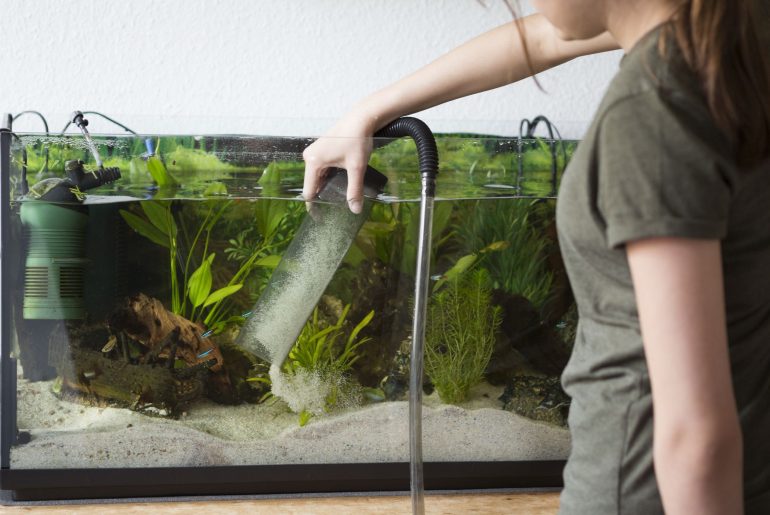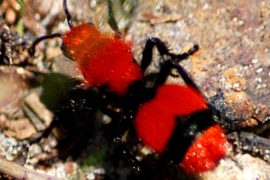Regular maintenance of the aquarium also includes cleaning the substrate. You can read about what you should consider when caring for the aquarium floor in order to optimally support the growth of the aquarium plants in this small guide on the topic of aquariums: “Cleaning the floor”.
Cleaning the floor in the aquarium: tips for a clean tank
The substrate in the aquarium is normally cleaned during the water change as part of regular aquarium maintenance. This kills two birds with one stone: while the old aquarium water is drained out of the tank with the hose, sludge, plant residues, uneaten food and other remains that contaminate the bottom of the aquarium also get out. Many aquarium owners simply clean the bottom of the aquarium by vacuuming it with the hose. Others use cleaning aids such as B. a Mulgglocke.
Whichever method you use to clean the aquarium floor, make absolutely sure that you do not accidentally discard any animals with the rinse water when cleaning the aquarium floor. For this we give the following tips:
- Use a light-colored bucket for cleaning and water changes
With a look into the bucket you will see that animals have accidentally gotten into the changing water. If in doubt, wait a moment until suspended matter has settled, then you will have a clear view. - Watch out for offspring or small animals
If there are many small animals in the aquarium, cleaning with a hose is often difficult. In very critical cases, pull a net or women’s stocking over the hose and do not vacuum the floor. Only plant parts and coarse dirt are removed with plant tweezers or a landing net.
Clean the bottom of the aquarium: with the hose
If you want to clean the substrate in the aquarium without going too deep, it is sufficient to hold the hose close to the bottom so that the debris is also sucked up. Make sure that no aquarium plants are caught – the leaves are easily bent. Smaller plantlets can be accidentally uprooted. You should also be careful not to accidentally remove the substrate. Should this happen, carefully pour away the changing water, take the substrate out of the bucket and put it back into the tank.
Tip: Use the hose to create a kind of whirlpool with circular movements. Lighter parts are whirled up and sucked up, while the heavier substrate sinks and remains in the aquarium. This often makes cleaning the bottom of the aquarium easier.
Clean the floor in the aquarium: with the sludge vacuum cleaner
If the substrate is to be cleaned very thoroughly, we recommend using a mulm vacuum cleaner.
It works by tumbling up the substrate inside a plastic dome, releasing the dirt that has sunk into the substrate. This gets into the hose while the pebbles or sand on the ground sink down again. This makes it possible to clean the substrate in the aquarium particularly intensively. However, pay attention to a few points:
Don’t overdo it with cleaning.
You want to clean the substrate but not turn it into a clinically clean zone. It is quite normal and desirable that sludge sinks into the deeper layers. In a normal community tank, you don’t have to tweak the mulch until the water you’re stirring up is clear. Only remove the coarsest dirt.
Keep your distance from the aquarium plants.
A sludge vacuum is ideal for pools or areas that are not planted. Where a ground cover or a lawn in the aquarium covers the ground, it is of no use. But even plants that form widely branched roots in the aquarium can be uprooted by careless use of the sludge vacuum cleaner. Cryptocorynes, for example, form rhizomes that spread below the soil at some distance from the parent plant. Proceed carefully and if you come across a root, simply cover it carefully with substrate again.
Mulm in the aquarium: how often to clean the bottom?
The most common question on the subject of “cleaning the substrate”: How often is cleaning necessary? It is best to clean the substrate in the aquarium as part of the water change that takes place every one or two weeks. It is perfectly fine if parts of plants or sludge remain on the aquarium floor during these intervals: They form a valuable basis for the growth of bacteria, a source of food for microorganisms and often for the aquarium inhabitants themselves, such as fish and shrimp.
Basically, you should not be too meticulous when cleaning the substrate in the aquarium. But on the contrary:
Many animals love corners where Mulm is located. If you want to set up an aquarium for shrimp in which the animals feel particularly comfortable, you may even plan to have a few queasy corners. The offspring in particular will find sufficient food here. So, as long as there is no larger organic waste in the aquarium, wait until the next water change and do not clean every corner of the aquarium.
Clean the aquarium floor from time to time – clean the substrate without changing the water
Sometimes it is necessary to clean the substrate in the aquarium even though the water is not being changed. However, if there is too much organic waste at the bottom of the aquarium, cleaning the aquarium floor from time to time is definitely advisable. Above all, if the feeding was incorrectly calculated and leftover food collects on the bottom of the aquarium, it should be removed as soon as possible – otherwise there is a risk of the water parameters deteriorating. Fish and plants can be damaged and algae in the aquarium can be encouraged. There are various options for quick cleaning in between:
Cleaning the bottom of the aquarium with a thin hose
A very thin hose, as used for filter technology and the like, does a good job here. Small particles, such as the remains of flake food, can be easily sucked up with its help without losing too much aquarium water that has to be replaced.
Cleaning the aquarium floor with a cleaner
In the aquaristic trade, cleaners are offered that absorb the water, pass it through a filter and then return it to the aquarium. These electrically operated handheld devices are not essential, but are an additional way of keeping the bottom of the aquarium clean.
How do I start my fish tank gravel cleaner?
How do you completely clean aquarium gravel?
How often should you use a gravel cleaner?
If you have a healthy and well-balanced fish tank, you may be able to go for several months without cleaning the gravel. However, even with a highly efficient tank, it is a good idea to clean gravel at least once every two to three months.
How do you clean gravel without removing fish?
To clean the river gravel, simply put 2 cups of vinegar in a bucket with the gravel and fill it with water. Leave it for 1-2 hours and then empty the water from the bucket. By this time, most of the harmful bacteria and parasites should have died. Rinse the gravel a couple of times and it is ready to go in the tank!
Should you clean aquarium gravel?
Along with installing the proper filtration systems to maintain water quality, it’s also important to clean the gravel at the bottom of your tank to keep conditions healthy for your fish.
How often should I vacuum my fish tank gravel?
At least once a month you should use an aquarium vacuum to clean the gravel and a sponge or scraper to remove excess algae from the sides of the tank. In addition, you should also test the ammonia, nitrate, and pH levels and keep a log to make sure they are steady from month to month.
How do you remove fish poop from gravel?
Vacuum the Gravel Fish feces, shed scales, uneaten food, dead bits of plants, and other debris will settle to the bottom of your tank. Vacuuming the gravel every week will remove much of this debris and refresh the tank, brightening the gravel and keeping the tank healthier.
Do you leave fish in tank when cleaning?
It’s best to keep your fish in the fish tank when you clean. Removing them causes unnecessary stress for your fish, and you run the risk of accidentally hurting them. It is possible to keep your fish in the tank while you clean because you don’t need to remove all the water to clean the tank properly.





